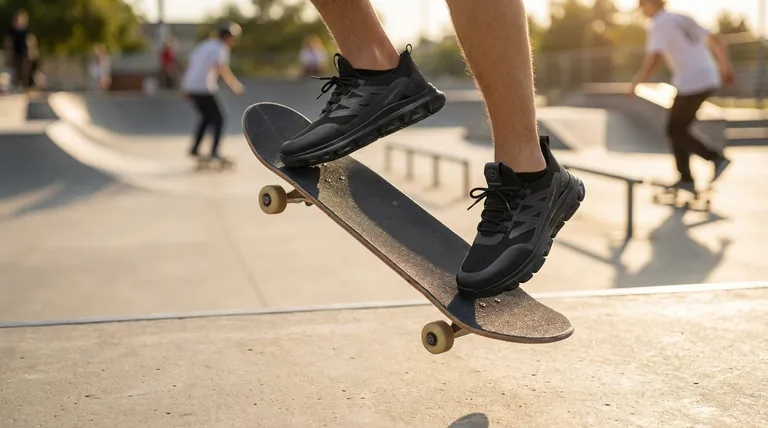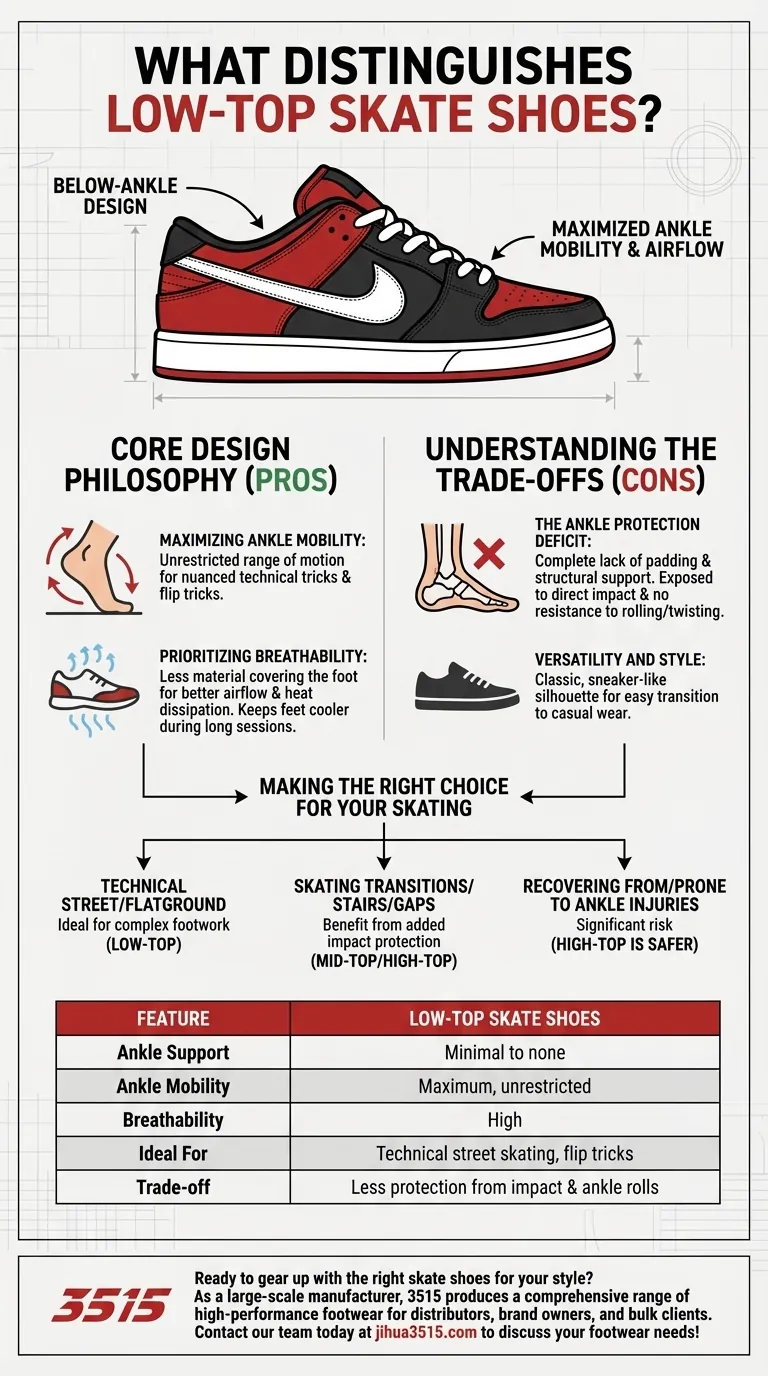At their core, low-top skate shoes are distinguished by a design that stops below the ankle. This specific cut is a deliberate choice to maximize ankle mobility and airflow at the direct expense of impact protection, making them the most common and versatile silhouette in skateboarding.
The decision to wear low-top skate shoes is a fundamental trade-off: skaters gain unparalleled freedom of movement for technical tricks by sacrificing the support and protection that might prevent common ankle injuries.

The Core Design Philosophy of Low-Tops
The prevalence of the low-top design isn't accidental. It directly supports the demands of modern technical skateboarding, where precision and agility are paramount.
Maximizing Ankle Mobility
The primary advantage of a low-top shoe is the complete, unrestricted range of motion it affords the ankle.
This freedom is critical for the nuanced foot and ankle adjustments required for flip tricks, where even slight material resistance can affect the board's rotation.
Prioritizing Breathability
By design, low-tops have less material covering the foot. This results in significantly better airflow and heat dissipation.
For skaters enduring long sessions, especially in warmer weather, this added breathability keeps feet cooler and more comfortable, reducing fatigue and sweat.
Understanding the Trade-offs: Protection vs. Freedom
While low-tops are the default for many, they are not without significant compromises. Understanding these drawbacks is crucial for any skater.
The Ankle Protection Deficit
The most obvious trade-off is the complete lack of padding and structural support around the ankle.
This leaves the ankle bones exposed to direct impact from the skateboard, a common and painful occurrence. Furthermore, low-tops offer no inherent resistance to rolling or twisting your ankle.
Versatility and Style
Part of their popularity stems from their classic, sneaker-like silhouette. Low-tops easily transition from a skate session to casual, everyday wear.
This off-the-board appeal contributes to them being the most common style, as they serve a dual purpose for many skaters.
Making the Right Choice for Your Skating
Ultimately, the right shoe depends entirely on your skating style, personal preference, and tolerance for risk.
- If your primary focus is technical street or flatground skating: The supreme ankle mobility of a low-top is ideal for the complex footwork of flip tricks.
- If your primary focus is skating transitions, stairs, or gaps: You may benefit from the added impact protection and support of a mid-top or high-top.
- If you are recovering from or are prone to ankle injuries: The lack of support in a low-top presents a significant risk, and a high-top is a much safer choice.
Choosing your footwear is about aligning your gear with your specific goals on the board.
Summary Table:
| Feature | Low-Top Skate Shoes |
|---|---|
| Ankle Support | Minimal to none |
| Ankle Mobility | Maximum, unrestricted |
| Breathability | High |
| Ideal For | Technical street skating, flip tricks |
| Trade-off | Less protection from impact and ankle rolls |
Ready to gear up with the right skate shoes for your style?
As a large-scale manufacturer, 3515 produces a comprehensive range of high-performance footwear for distributors, brand owners, and bulk clients. Whether you need durable low-tops for technical skating or supportive high-tops for transitions, our production capabilities encompass all types of skate shoes and boots.
Let us help you equip your customers with the perfect fit. Contact our team today to discuss your footwear needs!
Visual Guide

Related Products
- Wholesale Lightweight Cushioned Athletic Sneakers for Custom Bulk Production
- Wholesale Durable Camouflage Canvas Shoes with High-Traction Cleated Rubber Sole
- Durable Rubber-Soled Utility Shoes for Wholesale & Custom Brand Manufacturing
- Wholesale Breathable Athletic Sneakers - Custom Lightweight Cushioned Footwear Manufacturer
- Premium Safety Shoes with Rotating Buckle Safety Sneakers
People Also Ask
- Is it advisable to run in walking shoes? Avoid Injury with the Right Footwear
- What is the final recommendation for choosing between walking and running shoes? Optimize Comfort and Performance
- What are the benefits of wearing proper athletic footwear? Enhance Performance & Prevent Injury
- How does the sole design differ between walking and running shoes? Optimize Comfort and Performance
- Are running shoes suitable for walking? Discover the Surprising Cushioning Benefits



















